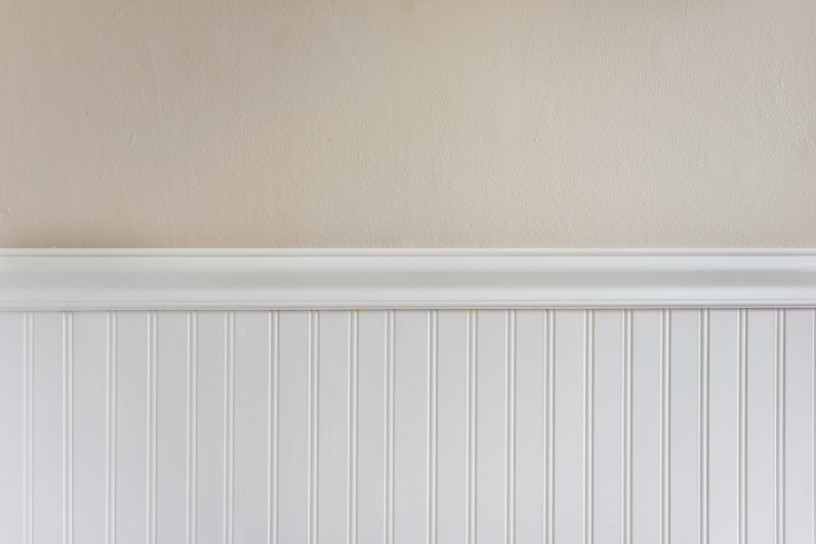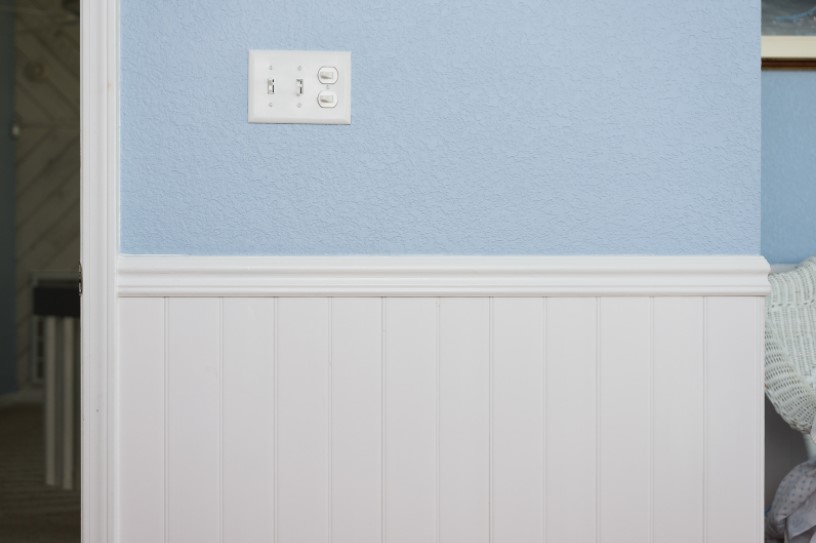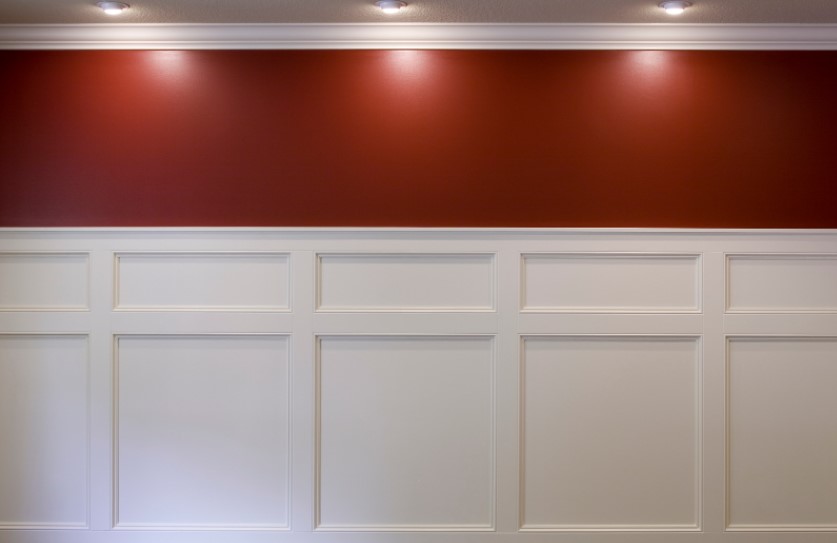One way to completely transform the look of a room is by changing the trim, and there is a multitude of options to choose from. Among these, wainscoting is one of the most popular.
In this article, we will provide all the essential information about wainscoting, including its definition, cost, as well as its advantages and disadvantages.
Let’s dive right in.
What is wainscoting?
Wainscoting, at its core, is a decorative and protective wall paneling system. It’s traditionally placed along the bottom half or third of a wall’s height, typically extending much higher than a standard chair rail. Though this installation height may vary based on style preferences and the room’s dimensions, the general concept remains consistent.
Not only does wainscoting serve a functional purpose, protecting the lower sections of your walls from scuffs, dings, and damage, but it also elevates the aesthetic quality of a room.
It can be used to create visual interest, break up large wall spaces, and add an element of architectural detail to otherwise plain walls.
History of Wainscoting
The origins of wainscoting date back to the 14th Century. The term “wainscot” is of Germanic origin, referring to a high-quality oak used for paneling. Over time, this term came to denote any form of “wood panels on walls.”
Wainscoting, as we understand it today, has a rich history of usage in old New England colonial homes. Here, it served a practical purpose: it acted as a form of separation between the living space and the animals.
This physical division, however, had an added benefit. It provided a degree of protection to the soft plaster interiors from the wear and tear of daily activities, including contact from chairs and other household chores.
Furthermore, wainscoting was introduced as an effective solution for enhancing interior insulation, a necessity for buildings and homes with stone walls.
The Purpose of Wainscoting
Back then, wainscoting helped to insulate rooms, particularly by providing acoustic and thermal insulation.
It also provided some protection for walls, especially since they were only papered at the time.
Nowadays, it is used solely for decorative element rather than functional.
Types of Wainscoting
There are a few types of wainscoting, and here are some of the most popular ones:
Beadboard Wainscoting: Beadboard wainscoting is characterized by evenly spaced vertical grooves (beads) along the surface of the panel. It is usually installed as tongue and groove boards, and it’s a popular choice for a cozy, cottage-style look.
Raised Panel Wainscoting: This is a classic type of wainscoting that features rectangular or square patterns in a frame. The panels are raised above the trim molding, providing a three-dimensional look. It’s often found in more traditional or formal settings, like dining rooms or studies.
Flat Panel Wainscoting: Also known as recessed panel wainscoting, this style features a flat panel inside a frame. It’s a versatile design that can fit into both traditional and contemporary interiors.
Board and Batten Wainscoting: Board and batten is a type of wainscoting where wide panels (boards) are separated by narrow wooden strips (battens). The result is a geometric, repetitive pattern that can add depth and interest to a wall.
What is wainscoting made of?
The materials used to construct wainscoting have evolved over time.
Today, we often see it made from medium-density fiberboard (MDF), a popular choice due to its smooth surface and resistance to warping. MDF also offers ease of painting, allowing homeowners to customize the color to fit their interior design.
Vinyl, another common material, is durable and water-resistant, making it an ideal choice for high-moisture areas such as bathrooms or kitchens.
Plywood provides a more budget-friendly option, while hardwood offers a luxurious, timeless appeal, often used in more traditional or formal settings.
What’s the difference between paneling and wainscoting?
Wainscoting and paneling, while seemingly similar, serve distinct purposes and add different visual aesthetics in interior design.
Wainscoting is a specific type of wall paneling that primarily covers the lower half or third of a wall. It usually includes decorative elements like moldings at the top and bottom, creating a framed effect.
This type of paneling is most often used as a form of wall protection against scuffs and dings, particularly in high-traffic areas of the home.
However, it’s not just about functionality; wainscoting also adds an element of architectural interest and charm to a space.
The combination of panels and molding creates a dynamic visual effect that can make a room feel more structured and elegant.
On the flip side, paneling is a more general term that describes the application of various materials to cover a wall surface partially or entirely. This could mean applying wood, vinyl, or other materials from floor to ceiling, thus transforming the entire look and feel of a room.
Paneling allows for a broad range of design styles, from the rustic charm of barn wood to the mid-century modern look of vertical wood panels.
What’s the difference between beadboard and wainscoting?
Many homeowners mistakenly use the terms “beadboard” and “wainscoting” interchangeably, but they actually denote different concepts.
To clarify, both beadboard and wainscoting refer to types of paneling; however, the term ‘wainscoting’ denotes a method that involves applying paneling to the lower half or third of a wall’s height.
On the other hand, ‘beadboard’ defines a specific style of panel, characterized by vertical lines.
Wall paneling comes in various styles, including shiplap, board and batten, raised panel, flat panel, and beadboard.
What is the cost of wainscoting?

Cost is always a significant factor when planning a home improvement project. In this regard, wainscoting often emerges as a cost-effective option due to its balance of affordability and aesthetic appeal.
The cost of installing wainscoting can fluctuate substantially, primarily influenced by factors such as the choice of material, the size of the room, and the labor costs.
Wainscoting Cost Based on Materials
Materials range from economical options like MDF and plywood to more high-end choices like solid hardwood. The choice of material can significantly impact the overall cost, with high-quality woods typically commanding a premium price.
For instance, medium-density fiberboard (MDF) wainscoting typically costs about $7-$17 per square foot. In contrast, solid wood panels can range from $15-$40 per square foot.
Note that the following cost estimates pertain only to materials, and labor costs are separate.
| Material | Average Cost per sq.ft. |
|---|---|
| Vinyl | $4-$7 |
| MDF | $7-$17 |
| Plywood | $7-$17 |
| Oak | $12-$30 |
| Maple | $13-$35 |
| Cherry | $14-$40 |
Wainscoting Cost based on Room Size
The size of the room is another vital consideration. Naturally, larger rooms require more materials and potentially more installation time, which can increase the total expenditure.
The table below displays wainscoting cost estimation based on typical room dimensions in the United States.
| Room Size | Average Cost per sq.ft. |
|---|---|
| 100 sq.ft. | $1000-$2500 |
| 200 sq.ft. | $1500-$3000 |
| 300 sq.ft. | $2000-$3500 |
| 400 sq.ft. | $2500-$4000 |
Wainscoting Installation Cost
Finally, labor costs can significantly affect the overall price. Depending on your locale and whether you opt for professional installation or choose a DIY approach, labor costs can fluctuate based on location, style, complexity, and types of finish.
On average, wainscoting installation costs in the United States range from $1,000 to $5,000.
It’s always advisable to consult with a trusted contractor to get accurate estimates and quotes for your specific project.
What are the pros of installing wainscoting?
Installing wainscoting in your home has several advantages. Here are some of the primary ones:
1. Improved Insulation and Wall Protection
Originating as an insulation solution, wainscoting continues to provide thermal benefits, making rooms more comfortable. Furthermore, it acts as a protective barrier, preventing scrapes and scratches on your walls, which is particularly useful in households with children.
2. Variety of Material Choices
Wainscoting can be tailored to match your home’s existing aesthetic or even coordinate with your furniture. Available in a range of materials like MDF or wood, it can be painted, stained, or decorated to suit your personal style.
3. Aesthetic Appeal
Wainscoting adds an elegant touch to any room. If you’re looking for a cost-effective way to transform the look and feel of a space, installing wainscoting might be the perfect choice for you!”
What are the downsides of installing wainscoting?
While wainscoting offers various benefits, including wall protection and insulation, it also comes with some disadvantages.
1. Susceptibility to Rot
Wooden wainscoting, being a natural material, is prone to rot when exposed to moisture, which can also attract pests like spiders or ants. That’s why it’s crucial to ensure your home has effective insulation to prevent excessive moisture buildup.
2. Potential for High Costs
Some wainscoting materials, such as exotic wood, can be expensive, with prices starting at around $40 per square foot. This doesn’t include the cost of professional installation, which these materials often require.
3. Risk of Deformation
Wooden wainscoting is susceptible to warping and bending over time. This is due to the natural moisture in wood evaporating over time, causing it to shrink and distort, potentially leading to gaps in the paneling.
4. Maintenance Difficulties
Finally, wainscoting can be challenging to alter once installed. For example, if you paint your wainscoting and later decide you want a different look, you’ll need to completely remove the wainscoting before repainting. This process can be time-consuming and potentially damaging to your walls.
Wainscoting Ideas

The world of wainscoting offers plenty of room for creativity. From exploring different colors and patterns to bending traditional rules, here are some ideas to help inspire your own wainscoting project.
1. Experiment with Colors
Don’t limit yourself to white wainscoting. Explore different hues that can complement your room’s existing decor or even set a new color scheme for the room.
2. Embrace Patterns
Who says wainscoting has to be plain? Implementing a pattern that mirrors your personality could be an exciting twist. Floral, geometric, or even thematic prints like nautical stripes can add a lively element to your room.
3. Aim for Harmony
Ensure that your wainscoting’s pattern aligns with your room’s overall aesthetic. If your room is decorated with geometric prints, a floral pattern on the wainscoting may seem out of place. Consistency is key to a cohesive design.
4. Partner with Wallpaper
Combining wallpaper with wainscoting can create an appealing visual effect. It can give the illusion of continuity, enhancing the perceived height of your wainscoting and giving it an elevated importance.
5. Understand Limitations
If you’re striving for a Victorian look, it might be tempting to extend the wallpaper onto the ceiling. However, this can lead to a cluttered look and make customization difficult in the future. Exercise restraint when appropriate.
6. Break the Rules
While the conventional guideline for wainscoting height is half or one-third of the wall, home improvement knows no limits. Feel free to deviate from the norm and adjust the height to your liking.
7. Take Your Time
Patience is a virtue in home improvement. Rushing the installation process might result in a sloppy finish. Invest your time wisely to ensure that your wainscoting project turns out flawlessly.
